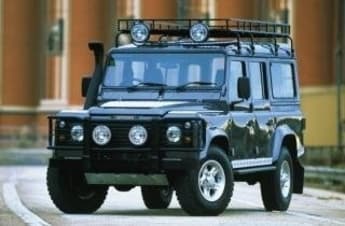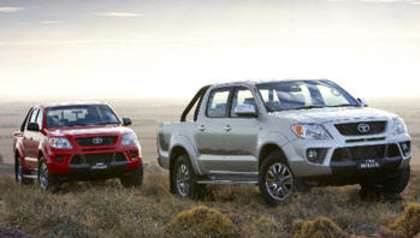At a time when most makers are launching their 2008 models and already have their EU4-compliant diesels available, Land Rover has launched its EU4-spec 2007 Defender.
But, having taken nearly 60 years to come this far, the Defender has never been a vehicle to rush into anything.
The “new” Defender is a stop-gap until an all-new Defender arrives about 2010.

To be sold between now and then, it needed an EU4-compliant engine, and the 2.4-litre unit from the Ford Transit fitted the bill (if not the Defender's engine bay).
The defining exterior feature of the '07 Defender is the bonnet bulge required because the Ford engine is taller than theTd5it replaces.
For the engine to meet Land Rover's criteria for off-road use, ancillaries such as the alternator and air-conditioning compressor were moved higher on the engine and sit snugly under the bump.
The new engine is a 2.4-litre iron-block, alloy-head design with 16 valves, common-rail direct injection, a variable-nozzle turbocharger and an intercooler.
It produces 90kW at 3500rpm and 360Nm at2000rpm, with more than 315Nm of that torque available from 1500 to 2700rpm.
Power is the same as in the Td5, but there's 60Nm more torque. ADR combined fuel figures are 11.0L/100km for the 110 wagon and 11.1L/100km for the 130 double-cab.
A new six-speed manual gearbox offers a broad spread of ratios to keep the Defender's modest power on the boil.
The torquier engine and wider gearing make it a more relaxed vehicle to drive, delivering 50km/h per 1000rpm in top gear and sub-2000rpm highway cruising.
You can now hear your passenger speak at a normal level on the freeway, even though the cabin still lacks the sound deadening and carpet of most modern vehicles.
The Defender's interior is now a much more comfortable place, thanks to a new dashboard with integrated air-conditioning.
Keen spotters will have noticed that the old vent flaps under the windscreen have been removed — that's because Defender now has a heating, ventilation and air-conditioning system that brings it into the 21st century.
Land Rover quotes a heap of figures about improved airflow and quicker heating and cooling, but the improvements simply provide what you would expect in a modern vehicle that is sold around the globe. Air-conditioning is fitted as standard equipment.
In yet another concession to modernity, there's an all-new dashboard incorporating a Discovery 3 gauge cluster, a modern audio system and simpler heating controls.
Combined with the improved seats, you could almost forget you were driving a Defender if it wasn't for the 1950s ergonomics and the handbrake digging into your left leg.
The new seats are taller, with proper headrests to make them more comfortable and safer.
In the 110 wagon, the second-row seat is also improved. It splits and folds to allow easier access to the rear, where a pair of third-row seats are a $2000 option.
Basic as the Defender's interior is, it has to be said the optional third-row seats are among the best and most comfortable available.
The Defender's high roof and square sides allow a more upright seat that is raised off the floor, providing proper leg-room and headroom for anyone up to 182cm in height.
The two seats sit outboard in the cargo space, leaving a passage between them for passengers to access the rear door.
When not in use, the seats fold up to the sides, where they take up a fair bit of cargo space. The third-row seats are a factory option that can't be retro-fitted, and all seats have three point belts.
The Defender range in Australia comprises just two models, despite the multitude of variants available in Britain.
Only the 110 wagon and 130 double-cab are sold here, although Land Rover Australia says it would like to be able to come up with a viable business case to sell the 90 here.
That should be easier now the 90 is available with the option of two extra seats.
The 110 and 130 share their driveline components, including full-time 4WD with high and low ranges. Live axles front and rear are suspended on long coil springs which provide plenty of axle travel.
The 110 has ABS and electronic traction control, but the 130 doesn't even get a limited-slip rear diff. I can hear the farmer swearing from the bottom paddock, where his Defender ute is stuck in a boggy hole.
The value of electronic traction control was clearly shown over a section of deeply rutted track with holes almost perfectly placed to lift diagonally opposing wheels.
When the 110 lifted its wheels and stopped, the ETC could be heard braking the spinning wheel and sending drive to the wheels with grip, keeping the wagon moving.
When the 130 reached that spot, it simply stopped, wheels spinning in the air. It could advance only by using a lot more momentum.
Although the Defender now has a bit of refinement, this has never been a model bought for its comfort. It's a purpose-built enthusiast's vehicle, not a soccer mum's SUV.
It continues this tradition for the time being, but it's anyone's guess what will come after 2010.
With the Jeep Wrangler's resurgence and the introduction of the Hummer brand to Australia, there's a swell of popularity for military-inspired four-wheel drives — and, in that regard, the Defender is the real deal.
Land Rover Defender 2007: 110 (4X4)
| Engine Type | Diesel Turbo 4, 2.4L |
|---|---|
| Fuel Type | Diesel |
| Fuel Efficiency | 11.1L/100km (combined) |
| Seating | 5 |
| Price From | $13,970 - $18,370 |
Range and Specs
| Vehicle | Specs | Price* |
|---|---|---|
| 110 (4X4) | 2.5L, Diesel, 6 SPEED MANUAL | $19,580 - $24,750 |
















.png)












.jpg)
